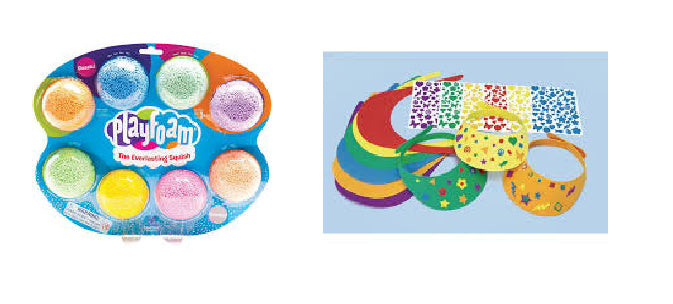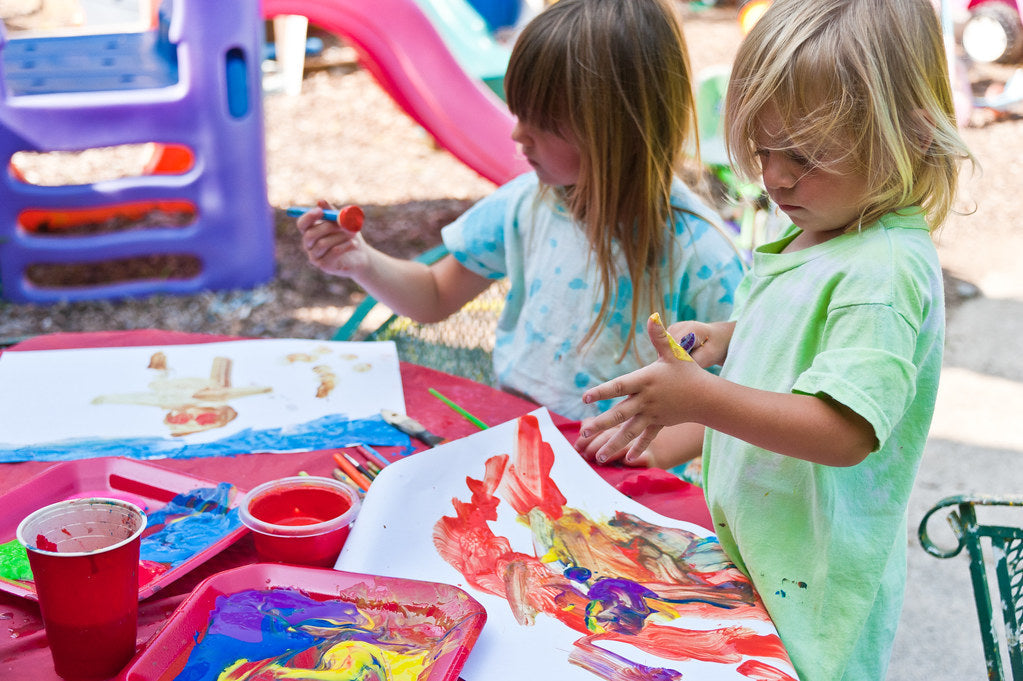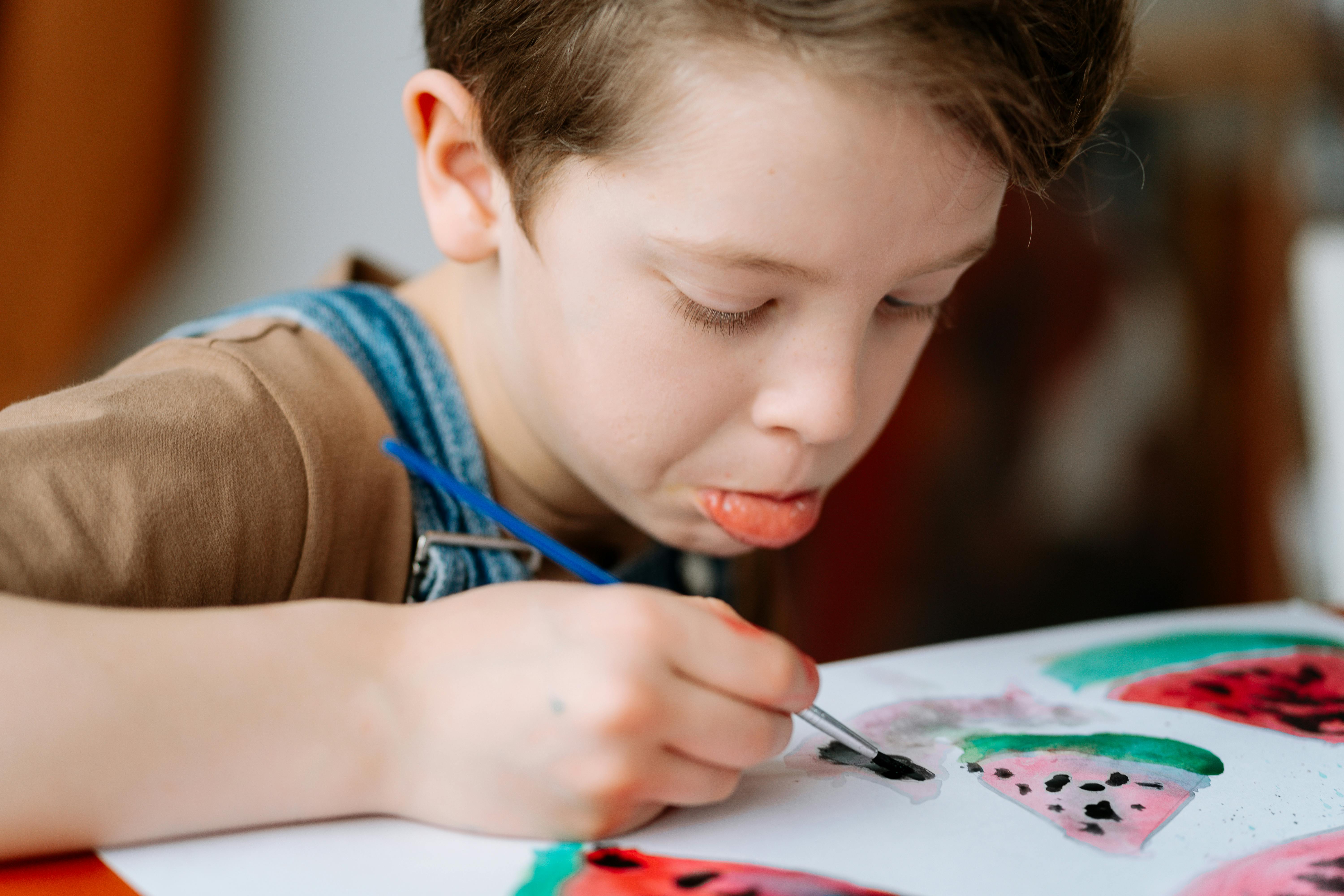
Making Kids Art Projects More Eco-Friendly
April 21, 2021
By Beth Herrild
As an artist and a business owner, I think a lot about how to be as environmentally conscious as possible. We’re always thinking about how to create more kids’ eco-friendly art projects! Like many of you, no doubt, it often feels like we are trying to choose the lesser of the evils. But I believe there really is a lot we can do if we put our minds to it. Necessity has always been the mother of invention. At Outside the Box Creation, we try to purchase products that are as green as possible whenever possible and we’re always trying to come up with new kids eco-friendly art projects.
Avoid Dangerous Chemicals
We avoid specific pigment/colors in paints like Cadmium Red, Cadmium Orange, and Cadmium Yellow that contain cadmium sulfide and cadmium selenide. We don’t use art supplies like true oil paints, that need to be cleaned up with solvents that are toxic, like paint thinner. Now there are options in water soluble oil paints that require no solvents! One very positive development is that many of the supplies that are potentially toxic now must carry warnings, so they are easier to identify.
Avoid Non-Biodegradable Materials
Other than dangerous chemicals, there are a whole host of products sold in art stores, as art supplies for kids, that are horrible for the environment! Fun Foam is one material we try to stay away from. It is often called “craft foam” and sometimes it is called “Foamies”. It’s inexpensive and very easy to use for crafts, easily cut, sturdy, kind of like a fabric with a little sponginess to it. But Fun Foam is made with either PVC or EVA. The PVC off gasses toxic fumes. The EVA is a little better from that standpoint, but the bottom line is that the foam does not break down in a landfill! Not to mention the fact that most of the Fun Foam projects done with kids in pre-schools, schools, and daycares are not creative art projects but rather a craft project where kids glue pre-cut stuff onto other stuff. These are not activities that kids get a lot out of, but rather something to keep them busy. Fun Foam has no place in kids eco-friendly art projects.

In our boxes, we use compostable water cups and compostable paint mixing trays. Other supplies, like our plastic palettes are re-usable an infinite number of times. The brown kraft paper we use as a packing material is also meant to do double duty as a cover to protect work surfaces.

New Ways to Be Eco-Friendly and Save Money
We also just launched our new membership program, The Outside the Box Creation Insider’s Club! One of our main goals with this program, is to help parents do awesome art projects with their kids while using mostly supplies they already have! The membership is all digital. We suggest art supplies for the projects and then give parents alternatives that will also work. Then, if they want or need to purchase just a supply or two, we offer convenient links to do so. That way, we aren’t sending supplies that they already have to these families each month. After box subscribers have been with us for a year or two, they can move on to the digital membership because they will have collected a lot of art supplies while they received the boxes. The same goes for families who have a fairly large stash of art supplies already without even subscribing to our boxes! The insider’s Club helps save the environment and helps families save money.
Use Recycled/Upcycled Materials
Besides avoiding toxic chemicals, materials that don’t biodegrade, and transitioning to recyclable and compostable products when possible, how can we continue to create more eco-friendly art projects? One obvious way is to create art from recycled materials. We have done some boxes that used almost totally recycled materials for the project. For our December 2020 box, we purchased used CDs from a local creative re-use center called Tinkertopia in Tacoma, WA. Using recycled/upcycled materials also gives kids a chance to use their creative problem solving skills to use materials in non-traditional ways. Places like Tinkertopia and Seattle ReCreative are popping up all over the country. Very often, they also offer workshops. They’re also great places to donate your unused art and craft supplies instead of putting them in the landfill. Here on Whidbey Island, we have Arts & Craft Supply Swaps periodically at the community center. If you can’t find such a thing in your community, perhaps you could start one?
Using recycled materials could inspire us to paint on non-traditional surfaces like old book pages, masonite, cork, discarded building materials, whatever you have laying around. Striving to be eco-friendly is also inspiring people to create their own pigments and dyes from materials in nature. Here’s an article on planting your natural dye garden. There are quite a few people doing what they call eco-printing right now. It involves using plant materials to print on paper and fabric using just the naturally occurring pigments in the plant materials. We have a few videos of projects that you can do with your kids using materials you probably already have in your home, like these Torn Paper Collages or Toilet Paper Roll Critters!
Professional Artists Who Are Leading the Way
There are quite a number of professional artists making amazing artwork from recycled objects. Hopefully we will see these artists gaining more and more popularity and publicity! I enjoy Michelle Reader’s work. Here are six environmental artists who work for social change. In March of 2019, 140 artists came together in London’s The Other Art Fair with a theme of creating a Greener Future. One super interesting part was an initiative called Upcycle, where people could bring old artwork in and have an artist re-work it for a nominal fee. I’m sure most of us have an old print or painting that we no longer enjoy. That is such an innovative idea!

If you have young children, there are a growing number of eco-friendly art and craft materials available for those ages. These range from paints made from vegetables to soy based products and beeswax crayons. Mindful Momma has a great comprehensive list. You can also make your own natural modeling clay. One thing I liked to do with my kids was finger painting with pudding. Unfortunately some of the eco-friendly supplies are quite a bit more expensive than the mass produced traditional arts and crafts supplies. Hopefully as more and more of us begin purchasing the eco-friendly versions and less people purchase the traditional versions, the balance will shift. I firmly believe that we, as consumers, need to put pressure on companies to adopt more eco-friendly ways. Using our wallets to drive change is one of the most effective ways. If we all do our best in not using or limiting use of non eco friendly materials, purchasing more eco friendly materials when we can, using recycled and upcycled materials, we can do our part to protect the earth and still make amazing artwork! If you have found new environmentally friendly ways to create art, please comment and share!

